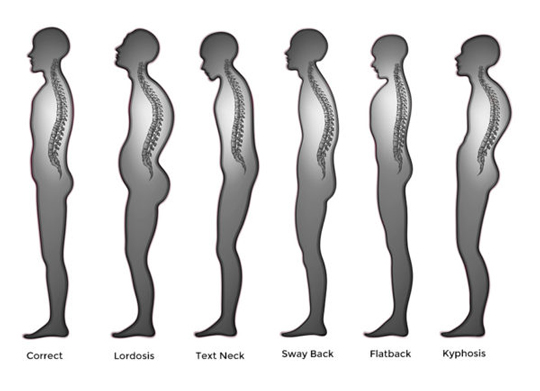The human body is meant to move, and holding it in unnatural postures for extended periods of time places a lot of pressure and strain on your spine. Activities such as sitting at a desk or looking down at your phone can create this pressure and as a result, cause back and neck pain.
It is said, “the best posture is always the next posture”. This means the best thing you can do to improve your posture and reduce the risk of back and neck pain is to keep your body moving throughout the day. Even some simple stretches at your desk or taking a quick walk across the office to the water cooler and back will help your body to reset itself.
Below are the five main types of bad posture and the long-term effects they cause on the body if not corrected. Check out our video below that guides you through 10 simple exercises you can do to help improve your posture.
Main Types of Bad Posture
Lordosis
When the spine curves too far inward in the lower back, making the buttocks appear to be sticking out.
Forward Head Posture
When the head is extending forward past the shoulders, caused by tilting our heads forward to look at our phones and computers. This is also known as “text neck”.
Flatback
When the lower spine loses its curve and flattens out, which results in leaning forward and difficulty standing up straight.
Swayback
The pelvis is pushed forward, forcing the body to try to compensate for the misalignment by shifting the upper back backward.
Kyphosis
Rounding forward of the shoulders, also known as slumping or slouching, and in extreme cases, hunchback.

Long-Term Effects of Bad Posture
Muscle Imbalances
The human body is designed to stand strong and straight with the ankle, knee, hip, and shoulder bones stacked in a vertical line. With poor posture, the surrounding muscles become overworked. Your muscles try to compensate for the imbalances which cause tension to build in the lower back, neck, shoulders, and hips. That tension not only triggers painful knots and spasms but also places you at a much higher risk of injury and more serious conditions. Good posture helps to prevent tension from building up in the first place and reduces the risk of more serious complications down the road.
Stress on the Spine from Sitting
Sitting is an unnatural position that forces the spine and surrounding muscles to compress and tighten. The longer you hold that position, the more difficult it becomes to release the pressure and realign the spine to its proper curvature. This leads to chronic back pain, tension headaches, and degradation of the tissues surrounding your joints.
Spinal Degeneration
If steps aren’t taken to correct bad posture, the spine will start to deteriorate if misaligned for too long. This could lead to harmful conditions that will impact your ability to perform daily routines. These conditions include unnatural spinal curvature, inflammation, nerve damage, herniated discs, formation of bone spurs, weakness in the limbs, and pain in areas unrelated to the spine.
Negative Mood
Recent studies show that people who slouch have increased feelings of depression and fatigue. This is due to the body having to work harder to hold you upright, which drains your energy and mood. Even our language reflects this connection between proper posture and emotional effect. Someone weak is “spineless” and someone proud has a “backbone”.
How to Fix Bad Posture
In the video below, Exercise Corrective Specialist Josh Lewis guides you through 10 exercises you can use in your daily routine to improve posture.
Find Relief Now. Pay Later.
Now you can try Teeter in your own home FREE for 30-Days, 0% APR* with Affirm.
